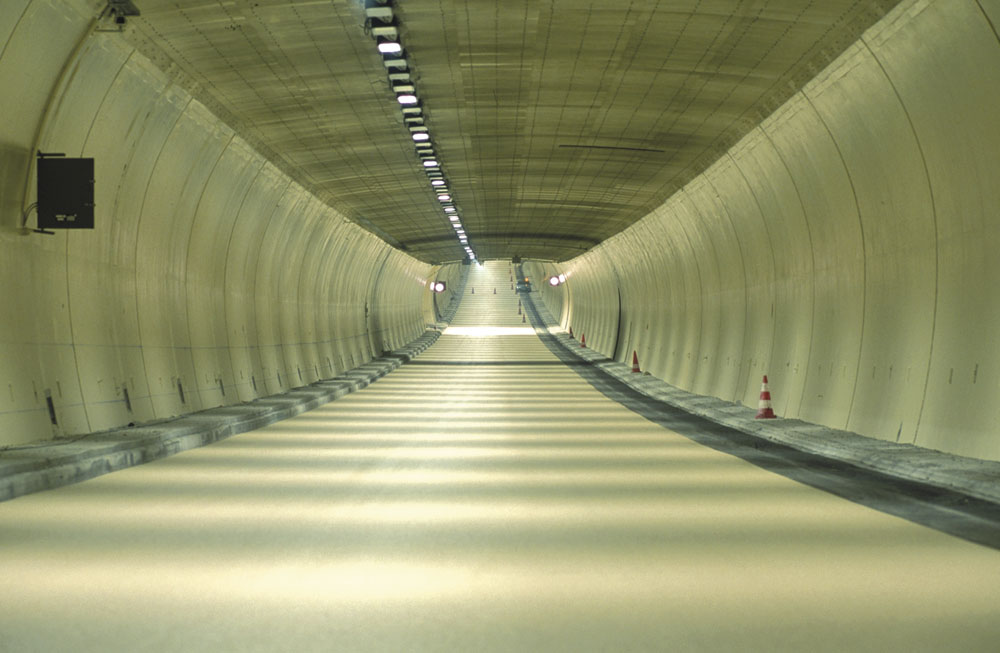Coloured Asphalt: The Road To Cost And Carbon Savings?

Road authorities across Europe are using light-coloured asphalt in tunnels to cut lighting costs without compromising driver safety. James Freeman, national special products manager at Tarmac, looks at how this innovative approach could soon be adopted on UK roads
Highways carbon management and a greater need to cut operational costs have cast the lighting of UK roads into the spotlight.
Across Europe, road tunnel operators have realized the environmental and financial benefits of laying light-coloured asphalt surfaces in tunnels.
Highway resurfacing work undertaken by Colas Geneve1 in the Confignon Tunnel, near Geneva, Switzerland, using this technology has led to a reduction in lighting and helped to deliver financial savings of 30–40% per annum.
Field trials on the project found that one spotlight in every two could be turned off because of the luminance of the light-coloured surfacing. These lighting savings have meant that, as well as benefiting the environment, additional capital costs for resurfacing were recouped within just four years.
Luxembourg is another country which has combined reflective road-surfacing materials with lighting technologies. Resurfacing around 1,575m of the Markusberg Tunnel with light-coloured asphalt has ensured that the number of lights in the tunnel can be reduced, helping to save 400,000kWh of energy a year, and cutting annual energy costs by €39,000 and maintenance costs by €16,0002.
The science behind it
Scientific studies confirm that driver visibility is not affected by light-coloured asphalt. A three-month study conducted by the International Commission of Illumination revealed that light-coloured asphalt delivers the highest specular reflection factor and luminance coefficient of any material. It recognized that while conventional asphalt does not pose any driver visibility concerns, the clarity value of clear asphalt is excellent.
What could this mean for the UK?
In the UK, the potential for light-coloured asphalt has not been fully realized. Currently, it is used to demarcate areas such as bus and cycle lanes, but the benefits of luminance and durability that this material offers have yet to be exploited.
Although this is unlikely to signal the end for conventional asphalt, there are many stretches of road, as well as tunnels and junction approaches, where the reflective qualities of light-coloured asphalt surfacing has the potential to deliver better driver visibility and to reduce lighting costs and carbon emissions.
Production
In order to provide local authorities with a high-quality, light-coloured asphalt, Tarmac have developed Mastertint. It provides all the qualities of conventional asphalt with pigment to ensure that the colour is retained throughout the product.
The light-coloured asphalt is mixed and formulated in line with the same principles as conventional asphalt, but combines cellulose fibres and pigments with Shell Mexphalte C, a clear synthetic bitumen binder from Shell Bitumen. Mexphalte C incorporates polymers that deliver durability and performance in heavily trafficked applications.
Typically, an asphalt mix design study is conducted in the laboratory in order to determine the ideal mix of aggregate, filler and clear binder, and to ensure the mechanical results are in line with relevant asphalt mix standards.
Contractor laying considerations
There are a number of key considerations when laying light-coloured asphalt. Alongside the usual care required when using standard asphalt, such as temperature control and accurate measurement, all equipment involved in transportation, compaction and laying must be thoroughly cleaned before and after the process to maintain a uniform colour for the final mix.
It is also important to note that the lighter colour of the road surface means vehicle skid marks are more visible and, therefore, their cleaning and removal is necessary once a year (more often than on darker roads).
Although light-coloured asphalt is not the sole answer to cutting carbon and costs on UK roads, when combined with efficient lighting technologies it is an approach that could go some way towards cutting operational costs and increasing driver visibility. The successes of European neighbours should ensure that the UK takes advantage of this tried and tested technology.
References
- R. Seburger, Oct 2009
- A Guzzo, Le Moniteur magazine, Sept 1993


